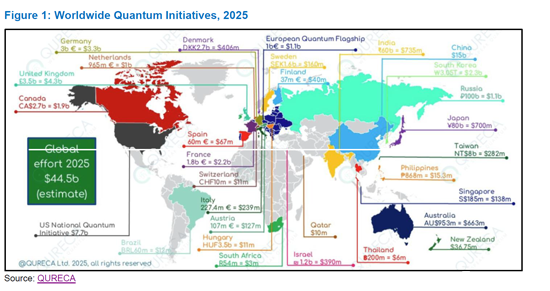PUBLISHER: MTN Consulting, LLC | PRODUCT CODE: 1720934

PUBLISHER: MTN Consulting, LLC | PRODUCT CODE: 1720934
India's Quantum Communication Journey - Insights from the International Quantum Communication Conclave 2025: Government, Academia, and Industry Unite to Drive India's Quantum Future with Indigenous Innovations in QKD, PQC, and Photonic Chips
This brief outlines the strategic initiatives, innovations, and milestones showcased at the International Quantum Communication Conclave 2025 that are steering India's progress toward future-ready quantum networks.
VISUALS

India is fast emerging as a significant player in the global race toward secure, quantum-based communications. The International Quantum Communication Conclave (IQCC) 2025 spotlighted India's growing capabilities in this field, with quantum communications (QC) poised to become the backbone of future secure networks. Unlike traditional encryption, quantum communication leverages the laws of quantum mechanics, offering resilience against classical and quantum cyber threats. As global investments in quantum technologies exceed $44.5 billion, India is strategically positioning itself to lead with indigenous innovations and national-scale deployments.
The Indian government has made quantum communications a core pillar of its National Quantum Mission (NQM), aiming to create a robust ecosystem of research, commercialization, and deployment. Several institutions such as Indian Institute of Technology (IIT) Madras, the Centre for Development of Telematics (CDOT), and the Raman Research Institute (RRI) are spearheading foundational projects. For example, IIT Madras has pioneered the Metro Area Quantum Access Network (MAQAN) metro fiber testbed in Chennai, while C-DOT's live Quantum Key Distribution (QKD) setup at Sanchar Bhawan, New Delhi marks an important milestone. Separately, IIT Delhi and the Defence Research and Development Organisation (DRDO) have jointly demonstrated entanglement-based QKD over 50 km of fiber link in lab conditions and 8 km of optical fiber in field trials, in addition to executing a 100 km inter-city QKD trial between Prayagraj and Vindhyachal in Uttar Pradesh. Building on these, the ambitious Quantum Internet with Local Access (QUILA) program aims to link major Indian cities through a 2,000 km quantum backbone, integrating terrestrial and satellite QKD with Post-Quantum Cryptography (PQC) and quantum memory, laying the foundation for a national quantum internet.
CDOT, emerging as the country's quantum commercialization engine, has developed certified QKD systems based on Coherent One Way (COW) and Differential Phase Shift (DPS) protocols. CDOT also is prototyping Measurement Device Independent (MDI) QKD for mitigating side-channel attacks. Its innovations in multiplexed and multi-core fiber QKD remove the need for costly dark fiber while extending secure communication ranges to 120+ km. Critically, CDOT has indigenized key components like single-photon detectors, cutting costs by 90% and reducing foreign dependency.
Another major leap forward is the shift toward chip-scale QKD. Miniaturizing bulky quantum components into photonic integrated circuits will allow for scalable, cost-effective deployment across telecom and cloud networks. India is investing heavily in this direction via the Ministry of Electronics and IT (MeitY) and the Department of Science and Technology (DST), funding photonic chip R&D at institutions like Indian Institute of Science (IISc) and IITs. These chips will also form the building blocks for future 6G and AI infrastructure.
Satellite quantum communication is the next frontier. RRI, in collaboration with the Indian Space Research Organization (ISRO), is developing ground-to-satellite QKD systems with adaptive optics and precision tracking, offering a viable solution for long-distance, terrain-agnostic secure links. Their research in device-independent randomness and free-space optics enhances India's readiness for global-scale quantum communication networks.
Finally, industry players like QNu Labs are transitioning research into deployable systems by commercializing hybrid models that integrate QKD, PQC, and quantum random number generators. These efforts, aligned with NQM, mark India's emergence as a serious contender in the global quantum race - strategically, scientifically, and commercially.
Research Coverage
Organizations mentioned:
|
|
Table of Contents
Summary
Introduction
- Why does quantum communications matter?
IQCC 2025 key highlights
- National imperatives: the role of NQM, CDOT, and IIT Madras
- Foundational projects: MAQAN and QUILA
- Indigenous innovation by CDOT
- Miniaturization and scale: Toward chip-scale QKD
- Satellite-Based Quantum Communication: RRI and ISRO lead the charge
- QNu Labs: from R&D to deployment
- Post-Quantum Cryptography: Ready for Integration
- Global alignment and learnings: Toshiba, IBM, and Ericsson
Why India's quantum ecosystem matters?
Conclusion: India's defining leap in quantum communications
List of Figures
- Figure 1: Worldwide Quantum Initiatives, 2025
- Figure 2: Quantum Networks Deployment Projects across India




